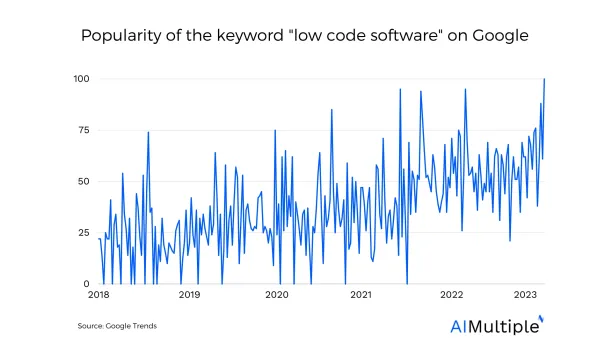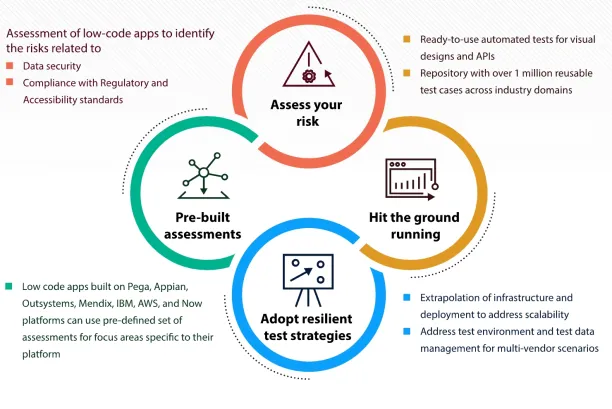Top 7 Low-Code Software in 2024: Vendor Selection Guide

Figure 1. Interest in low code app development platforms on Google search engine
Low code tools are gaining popularity in recent years as business users seek faster and more efficient ways to develop and deploy applications (Figure 1).
Research shows that low-code platforms help:1
- Decrease the costs by ~55%
- Accelerates the speed by ~60%
- Increases app revenue by ~60%
In this article, we present the top 7 low-code development platforms, comparing their capabilities and features to help businesses find the best solution for their specific needs.
Vendor selection criteria
After identifying whether the vendors provide the capabilities presented above, we narrowed our vendor list based on some criteria. We used the number of B2B reviews and employees of a company to estimate its market presence because these criteria are public and verifiable.
Therefore, we set certain limits to focus our work on top companies in terms of market presence, selecting firms with:
- 500+ employees
- 200+ reviews on review platforms including G2, Trustradius, Capterra
- at least one Fortune 500 reference
As all vendors offer a visual development environment, cross-platform support, and integration with other tools, we did not include these capabilities in the table. Below you can see our analysis of low code development tools in terms of the capabilities and features mentioned above. You can sort Table 1, for example, by the offline data synchronization capabilities.
| Vendor Name | Overall ratings* | Ease of use* | Pricing options | Free Trial | Quality of support* | UI customization | Deployment options | Offline data synchronization | Security measures |
|---|---|---|---|---|---|---|---|---|---|
| Appian | 4.5/5 | 8.7/10 | Not provided | ✅ | 8.4/10 | ✖️ | Appian cloud | ✅ | ISO 27018:2019, SOC 1, SOC 2, SOC 3, HIPAA |
| Creatio | 4.6/5 | 9/10 | $300 per user / year with monthly commitment options | ✅ | 9.1/10 | ✅ | On-site or hybrid | ✅ | ISO / IEC 27001: 2013, HIPAA, GDPR |
| Microsoft Power Apps | 4.1/5 | 7.8/10 | $60 per user / year with monthly commitment options | ✖️ | 7.7/10 | ✅ | AWS | ✅ | ISO 27001, GDPR |
| OutSystems | 4.6/5 | 9.2/10 | Not provided | ✅ | 8.5/10 | ✅ | Outsystems cloud | ✅ | ISO 27001, SOC2 Type II, PCI DSS |
| Quickbase | 4.4/5 | 8.8/10 | $600 per team / month | ✅ | 8.8/10 | ✅ | On-site | ✖️ | ISO 27001, SOC 1, SOC 2, HIPAA, GDPR |
| Salesforce Platform | 4.4/5 | 8.2/10 | $300 per user / year | ✅ | 8.3/10 | ✅ | AWS | ✅ | ISO 27018:2019, HIPAA, GDPR, SOC 1, SOC 2, SOC 3 |
| ServiceNow App Engine | 4.5/5 | 8.9/10 | Not provided | ✅ | 8.6/10 | ✅ | On-site | ✅ | ISO 27001, SOC2 |
*Based on data gathered from G2.
Disclaimer:
The data is gathered from the websites of vendors. If you believe we have missed any material, please contact us so that we can consider adding it to our article.
Low-code platform capabilities

Source: Infosys
Figure 2. Capabilities of using low code platforms visualized.
1- UI customization
UI customization is a key capability of low-code platforms. It enables users, even without extensive coding expertise, to design the application’s user interface according to their needs.
- Drag-and-drop interface: This feature allows users to easily add and arrange UI elements such as buttons, forms, and images on a canvas.
- Pre-built templates: Low-code platforms often provide templates for different applications and screens, which users can further customize to suit their preferences.
- Responsive design: This feature ensures that the application adapts to various screen sizes, enhancing the user experience across devices.
- Custom styling: Users can adjust style properties like colors and fonts to match their brand identity.
- Real-time preview: This allows users to view and refine the design before deployment.
2- Integration with other tools
Low-code platforms often come with pre-built connections with recognized third-party services, APIs, and apps. This streamlines workflows and eliminates the need for manual data entry by enabling users to connect to and share data between various platforms.
3- Visual development environment
The user-friendly, drag-and-drop interface of low-code platforms allows developers and non-developers to design, construct, and customize programs visually. This involves creating user interfaces, workflows, and data models without requiring considerable hand-coding.
4- Cross-platform support
Low-code platforms enable applications to be deployed on a variety of platforms, including web, mobile, and desktop, with few adjustments. This allows companies to reach a larger audience while also catering to diverse device preferences.
5- Offline data synchronization
Offline data synchronization is a feature provided by some low-code platforms, allowing users to access and interact with data even when they are not connected to the internet. This functionality is particularly important for mobile applications where users may experience intermittent connectivity or work in areas with limited network coverage.
6- Security and compliance
Many low-code platforms include security features and can be configured to meet industry-specific compliance requirements. This ensures that applications built on these platforms are secure and compliant with relevant regulations.
Transparency statement:
AIMultiple is sponsored by numerous emerging tech companies which may have received links from this article.
Further Reading
- Top 7 No-Code Software
- Top 15 Low-Code/No-Code Web Scrapers
- 32 Low-Code/No-Code Statistics from Reputable Sources
If you need help in your vendor selection process, we can help:
External Links
- 1. “The State of Low-Code 2021” (PDF). Mendix. Retrieved May 3, 2023.

Cem is the principal analyst at AIMultiple since 2017. AIMultiple informs hundreds of thousands of businesses (as per Similarweb) including 60% of Fortune 500 every month.
Cem's work has been cited by leading global publications including Business Insider, Forbes, Washington Post, global firms like Deloitte, HPE, NGOs like World Economic Forum and supranational organizations like European Commission. You can see more reputable companies and media that referenced AIMultiple.
Throughout his career, Cem served as a tech consultant, tech buyer and tech entrepreneur. He advised enterprises on their technology decisions at McKinsey & Company and Altman Solon for more than a decade. He also published a McKinsey report on digitalization.
He led technology strategy and procurement of a telco while reporting to the CEO. He has also led commercial growth of deep tech company Hypatos that reached a 7 digit annual recurring revenue and a 9 digit valuation from 0 within 2 years. Cem's work in Hypatos was covered by leading technology publications like TechCrunch and Business Insider.
Cem regularly speaks at international technology conferences. He graduated from Bogazici University as a computer engineer and holds an MBA from Columbia Business School.
Sources:
AIMultiple.com Traffic Analytics, Ranking & Audience, Similarweb.
Why Microsoft, IBM, and Google Are Ramping up Efforts on AI Ethics, Business Insider.
Microsoft invests $1 billion in OpenAI to pursue artificial intelligence that’s smarter than we are, Washington Post.
Data management barriers to AI success, Deloitte.
Empowering AI Leadership: AI C-Suite Toolkit, World Economic Forum.
Science, Research and Innovation Performance of the EU, European Commission.
Public-sector digitization: The trillion-dollar challenge, McKinsey & Company.
Hypatos gets $11.8M for a deep learning approach to document processing, TechCrunch.
We got an exclusive look at the pitch deck AI startup Hypatos used to raise $11 million, Business Insider.
To stay up-to-date on B2B tech & accelerate your enterprise:
Follow on

Comments
Your email address will not be published. All fields are required.